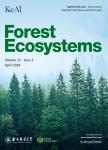Which trees should be removed in thinning treatments?
Which trees should be removed in thinning treatments?作者机构:University of Eastern FinlandPO Box 11180101 JoensuuFinland Joen Forest Program ConsultingRauhankatu 4180100 JoensuuFinland
出 版 物:《Forest Ecosystems》 (森林生态系统(英文版))
年 卷 期:2016年第3卷第1期
页 面:51-62页
核心收录:
学科分类:0710[理学-生物学] 0830[工学-环境科学与工程(可授工学、理学、农学学位)] 0907[农学-林学] 090704[农学-森林经理学] 0829[工学-林业工程] 09[农学] 0901[农学-作物学] 0833[工学-城乡规划学] 0713[理学-生态学] 0834[工学-风景园林学(可授工学、农学学位)]
主 题:Continuous cover forestry Tree selection High thinning Optimal management Spatial distribution,Spatial growth model
摘 要:Background: In economically optimal management, trees that are removed in a thinning treatment should be selected on the basis of their value, relative value increment and the effect of removal on the growth of remaining trees. Large valuable trees with decreased value increment should be removed, especially when they overtop smaller trees. Methods: This study optimized the tree selection rule in the thinning treatments of continuous cover managemen when the aim is to maximize the profitability of forest management. The weights of three criteria (stem value, relative value increment and effect of removal on the competition of remaining trees) were optimized together with thinning intervals. Results and conclusions: The results confirmed the hypothesis that optimal thinning involves removing predominantly large trees. Increasing stumpage value, decreasing relative value increment, and increasing competitive influence increased the likelihood that removal is optimal decision. However, if the spatial distribution of trees is irregular, it is optimal to leave large trees in sparse places and remove somewhat smaller trees from dense places. However, the benefit of optimal thinning, as compared to diameter limit cutting is not usually large in pure one-species stands. On the contrary, removing the smallest trees from the stand may lead to significant (30-40 %) reductions in the net present value of harvest incomes.



